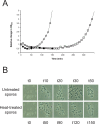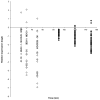Identification of CdnL, a Putative Transcriptional Regulator Involved in Repair and Outgrowth of Heat-Damaged Bacillus cereus Spores
- PMID: 26849219
- PMCID: PMC4746229
- DOI: 10.1371/journal.pone.0148670
Identification of CdnL, a Putative Transcriptional Regulator Involved in Repair and Outgrowth of Heat-Damaged Bacillus cereus Spores
Abstract
Spores are widely present in the environment and are common contaminants in the food chain, creating a challenge for food industry. Nowadays, heat treatments conventionally applied in food processing may become milder to comply with consumer desire for products with higher sensory and nutritional values. Consequently subpopulations of spores may emerge that are sublethally damaged rather than inactivated. Such spores may germinate, repair damage, and eventually grow out leading to uncontrolled spoilage and safety issues. To gain insight into both the behaviour of damaged Bacillus cereus spores, and the process of damage repair, we assessed the germination and outgrowth performance using OD595 measurements and microscopy combined with genome-wide transcription analysis of untreated and heat-treated spores. The first two methods showed delayed germination and outgrowth of heat-damaged B. cereus ATCC14579 spores. A subset of genes uniquely expressed in heat-treated spores was identified with putative roles in the outgrowth of damaged spores, including cdnL (BC4714) encoding the putative transcriptional regulator CdnL. Next, a B. cereus ATCC14579 cdnL (BC4714) deletion mutant was constructed and assessment of outgrowth from heat-treated spores under food relevant conditions showed increased damage compared to wild type spores. The approach used in this study allows for identification of candidate genes involved in spore damage repair. Further identification of cellular parameters and characterisation of the molecular processes contributing to spore damage repair may provide leads for better control of spore outgrowth in foods.
Conflict of interest statement
Figures


Similar articles
-
Influence of food matrix on outgrowth heterogeneity of heat damaged Bacillus cereus spores.Int J Food Microbiol. 2015 May 18;201:27-34. doi: 10.1016/j.ijfoodmicro.2015.02.010. Epub 2015 Feb 14. Int J Food Microbiol. 2015. PMID: 25727186
-
Germination and outgrowth of spores of Bacillus cereus group members: diversity and role of germinant receptors.Food Microbiol. 2011 Apr;28(2):199-208. doi: 10.1016/j.fm.2010.03.015. Epub 2010 Apr 8. Food Microbiol. 2011. PMID: 21315974 Review.
-
The combined effect of pasteurization intensity, water activity, pH and incubation temperature on the survival and outgrowth of spores of Bacillus cereus and Bacillus pumilus in artificial media and food products.Int J Food Microbiol. 2014 Jul 2;181:10-8. doi: 10.1016/j.ijfoodmicro.2014.04.018. Epub 2014 Apr 21. Int J Food Microbiol. 2014. PMID: 24801270
-
Analysis of Germination Capacity and Germinant Receptor (Sub)clusters of Genome-Sequenced Bacillus cereus Environmental Isolates and Model Strains.Appl Environ Microbiol. 2017 Feb 1;83(4):e02490-16. doi: 10.1128/AEM.02490-16. Print 2017 Feb 15. Appl Environ Microbiol. 2017. PMID: 27881417 Free PMC article.
-
Bacterial Spores in Food: Survival, Emergence, and Outgrowth.Annu Rev Food Sci Technol. 2016;7:457-82. doi: 10.1146/annurev-food-041715-033144. Annu Rev Food Sci Technol. 2016. PMID: 26934174 Review.
Cited by
-
Caulobacter crescentus CdnL is a non-essential RNA polymerase-binding protein whose depletion impairs normal growth and rRNA transcription.Sci Rep. 2017 Feb 24;7:43240. doi: 10.1038/srep43240. Sci Rep. 2017. PMID: 28233804 Free PMC article.
-
LtpA, a CdnL-type CarD regulator, is important for the enzootic cycle of the Lyme disease pathogen.Emerg Microbes Infect. 2018 Jul 9;7(1):126. doi: 10.1038/s41426-018-0122-1. Emerg Microbes Infect. 2018. PMID: 29985409 Free PMC article.
-
Regulation of the transcription factor CdnL promotes adaptation to nutrient stress in Caulobacter.bioRxiv [Preprint]. 2023 Dec 21:2023.12.20.572625. doi: 10.1101/2023.12.20.572625. bioRxiv. 2023. Update in: PNAS Nexus. 2024 Apr 10;3(4):pgae154. doi: 10.1093/pnasnexus/pgae154. PMID: 38187569 Free PMC article. Updated. Preprint.
-
Recovery of Heat Treated Bacillus cereus Spores Is Affected by Matrix Composition and Factors with Putative Functions in Damage Repair.Front Microbiol. 2016 Jul 18;7:1096. doi: 10.3389/fmicb.2016.01096. eCollection 2016. Front Microbiol. 2016. PMID: 27486443 Free PMC article.
-
House of CarDs: Functional insights into the transcriptional regulator CdnL.Mol Microbiol. 2024 Nov;122(5):789-796. doi: 10.1111/mmi.15268. Epub 2024 Apr 25. Mol Microbiol. 2024. PMID: 38664995 Review.
References
Publication types
MeSH terms
Substances
LinkOut - more resources
Full Text Sources
Other Literature Sources
Molecular Biology Databases

